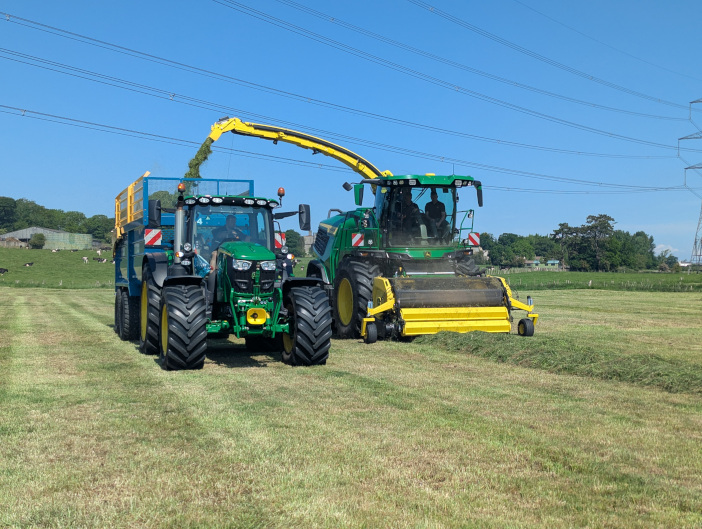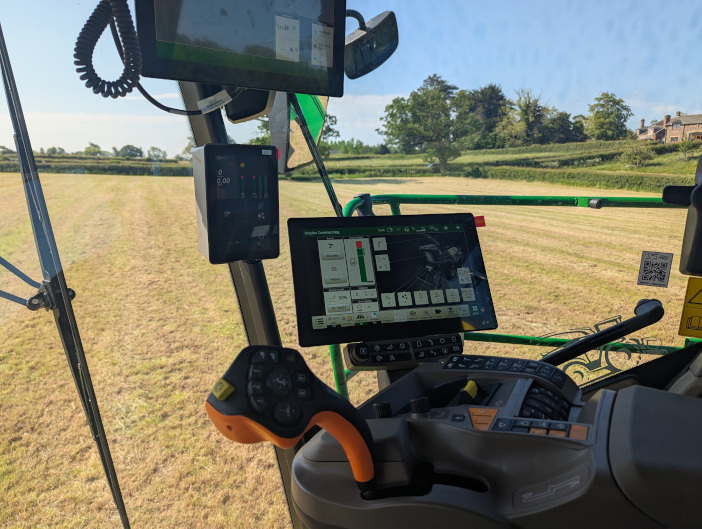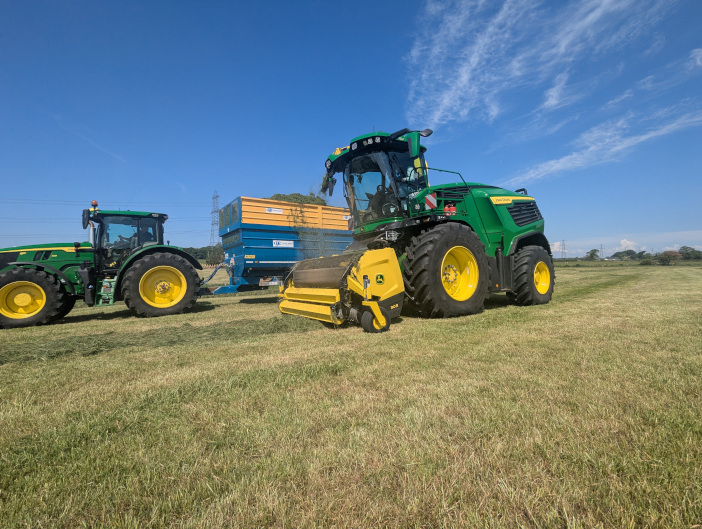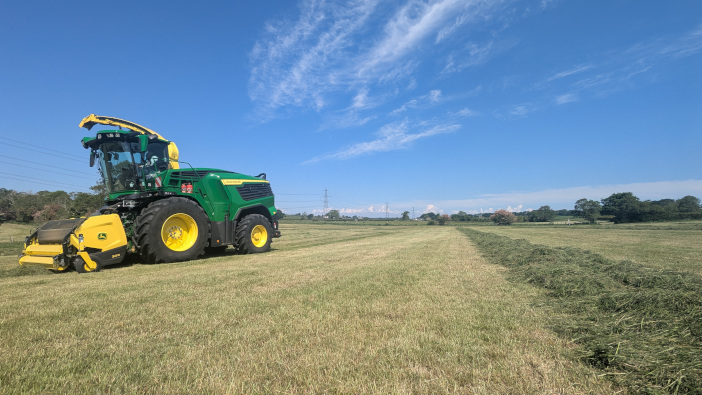Launching later this year, the F8 and F9 John Deere forage harvester series are said to be new from the ground up, with significant changes throughout to improve performance in grass, wholecrop and maize silage.
There are six models within the F8 range, all powered by the JD14X engine, brought across the X9 combine harvesters and certain models within the 9RX tractor range. It delivers outputs between 425hp on the F8 100 and 645hp on the largest F8 600.
Each model comes with the HarvestMotion system, which provides constant power across a wide curve, with automated engine speed management for transport and headland operations.
Jumping up to the F9 series and power comes from two different engine set-ups. Models from the F9 500 to the F9 700 are fitted with the JD18X, as seen in the latest flagship 9RX tractors.
These proven power units use a high-pressure, common rail fuel system, with serial turbochargers and cooled exhaust gas recirculation (EGR).
Notably, there is no need for AdBlue with this set-up. This uses the uprated HarvestMotion Plus system, which extends that power curve further to handle difficult crop conditions.
The final two models – the F9 900 and F9 1000, delivering up to 1,020hp – are powered by Liebherr 24.2-litre, V12 engines. These use the HarvestMotion system to keep fuel consumption as low as possible, or at least as low as you can expect from machines putting out that sort of power.
It’s interesting that John Deere opted to defer to Liebherr on these flagship models, given that the largest 9RX 830 uses the JD18X and pushes out a massive 913hp.
According to Ross Skimming, harvest territory sales manager, it wasn’t that the company’s own power unit couldn’t reach this headline-grabbing figure. Instead, John Deere chose the Liebherr engine to meet the increased loads of a forage harvester.
“It isn’t that the JD18X couldn’t break through that 1,000hp barrier, because we know it can,” he says. “But running a forager is just as much about fine-tuning how that power is distributed to handle the different load characteristics. We’ve used Liebherr extensively and we know the product works in these flagship forage harvesters.”
 Built for ease
Built for ease
The changes aren’t only a steady increase in the rated power across the board, but changes across nearly every part of the machine. Not of all these directly affect the output of the machine, but instead make a difference to the ease of maintenance.
For starters, every model is built around the same frame, regardless of whether it’s an F8 or F9 machine.
This increases the commonality of parts, as only the engine and crop channel width changes between the two ranges. It also means the F8 benefits from the same 1,500-litre fuel tank as the larger machines, increasing the time spent working.
At the rear of both the F8 and F9, the bumper has been redesigned to enable it to be easily lifted off with a forklift. As the ballast is integrated into the rear bumper, this can bring the time spent adjusting the weight down to a matter of minutes, according to Ross.
The 30-litre inoculant tank has been hidden behind a panel on the right-hand side of the machine, keeping the components clean and improving the aesthetics of the machine.
As standard, a clean water handwash tank has also been added. Inside the machine, the area where the corn cracker rollers are placed has been increased, with the various functions placed within easy reach of the operator.
On this note, John Deere has also upgraded the rollers that are available for the F-series. As well as the KP Ultimate set, with a 250mm diameter, it has developed its own KP XStream variant, which increases the diameter to 305mm – a 56% increase in surface area – and is said to offer 50% more crop processing.
This new model includes electric adjustment and proven oil-mist greasing for continued performance.
The increase is size means this roller system weighs nearly half a tonne and, as such, the crane system has been completely redesigned to easily lift these in and out of the forager. When lifted into the machine, the roller unit sits on tracks, meaning it can be manoeuvred into position.
For easy diagnostics, on the left-hand side of the machine, near the steps to the cabin, the access point for the new electronic architecture is protected within a sealed and cooled compartment. This should not only reduce the number of electrical problems caused by the ingress of dirt, but also speed up the process of diagnosing and fixing any issues.
 Working in comfort
Working in comfort
This new electronic architecture allows the F8 and F9 machines to run either the G5 or G5 Plus displays. These offer increased processing power over the previous generation, meaning more precision farming systems can be monitored through a single screen.
Operators can also specify an extended screen, placing a second monitor within the eye line.
The precision farming technology includes different versions of the AutoTrac guidance systems, including AutoPath Boundary and row steering options.
Active Fill Control allows the spout to automatically follow the trailer within reason and now includes a topping-off mode. To make unloading easier when controlling the spout manually, the overhaul includes adding an additional 20deg of movement – 10deg in each direction – to move through 230deg.
HarvestLab can also be added to the machine, with the new architecture making this easier to run through the single in-cab display. Monitoring the feed value of silage going through the machine in real-time, Ross notes that this has become a popular option for large farms, especially those running biogas plants, and contractors.
There’s also the option of a central tyre inflation system for the front axle, and while no official figures were available, Ross noted that the twin-compressor figures could bring the tyres up to road pressures within five minutes. Speaking of running gear, the rear axle has been completely redesigned, with a smaller overall chassis but the ability to fit 620 tyres.
“This means we have a turning circle of around 6m, regardless of the model,” explains Ross. “Our own tests have indicated that the F9 can turn within the footprint of the previous 9000 series.”
For operator comfort, the cabin from the X9 combine series has been brought over, with electronic sealing around the door for a pressurised and clean working environment.
As well as the new displays, John Deere has integrated an all new HydroHandle joystick, with 11 configurable Isobus controls. This and the G5 display are mounted on the armrest of the ActiveSeat, which can swivel 16deg right or left for clear visibility over the machine.
The optional ActiveSeat II adds a host of other technologies, including cooling and heating, a massage function and active suspension to dampen jolts through the machine.
 Performance in the field
Performance in the field
Jumping in the cab to see how the machine performed, it had no problems chewing the first-cut grass – in fact, there were several points where we had to slow down to make sure we didn’t run through the entire acreage too quickly. It was comfortable, even in the fold down passenger seat, and easy to operate.
As John Deere has integrated its G5 architecture across its new tractor, combine and now forager portfolios, there’s a familiarity to the control schemes which means it’s easy for new and experienced drivers to pick up.
The F8 600 we were testing was a pre-production model, and we were warned that it still had some adjustments to be made.
One of these is to the in-cab noise levels, though to be fair the combination of updates made throughout the machine has kept this down before any additional cladding. For starters, the engine now runs at 1,800rpm, and is rated to 2,000rpm.
It’s a seemingly small reduction from the 2,100rpm rated speed of the previous generation, but it does make a difference to the overall noise level. We were able to talk comfortably with Ross during the test without raising our voices.
The metal detecting system also works, as sheep had pulled part of the fence into the field and there was wire tangled up in the outer swath. The response was instantaneous, allowing Ross to stop the machine before any damage was done.
Part of the increase in performance can be attributed to the 30R grass pick-up. Previously, this had only been recommended for 9000 series foragers, but with the power increases and redesign, it can be used on both the F8 and F9 machines.
“That will be a game-changer for us,” says Ross. “That header is designed to handle 500t/hr, so the possible throughput even on the smaller machines is unbelievable.”
The contractor’s view
Nick Hoyle, who has run the F8 600 for several weeks of first cut grass and was reportedly instrumental in helping develop both the 30R header and this new range of foragers, was impressed with the unit.
“The improvements to the driveability are incredible,” he says. “You don’t necessarily notice everything until you jump back into the previous generation, but those small things add up.”
He covers a significant area of grass each year, with customers looking for up to five cuts, which is handled with two 9000 series foragers at present. “We’re overkitted, really, but having the second machine means we can get over the ground within the tight weather windows.”
While the new F8 can’t match his 9000s for output, he says that the performance and feeding capability are second to none, especially now that the 30R head can be mounted on the front.
“We’ve used every brand of forager and I haven’t found anything to match that pick-up. It just keeps going in all conditions, and we’ve barely had to touch it in three seasons. I don’t think we’ve even changed a tine.”
For more information go to www.deere.co.uk


